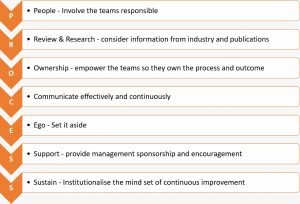7 Things You Must Do
If you are about to embark on a process improvement initiative, then this list of things to do will help ensure success. Such initiatives have had varying degrees of success. If you would like to get the most out of your investment of time and effort, then follow these simple yet effective guidelines to give your organisation the edge.
7 things to do when running a process improvement initiative
People – Involve the Teams Responsible
Do involve the people closest to the issue or problem in the process improvement teams. They are your best chance of getting to the core issues and resolving them. When you involve people, it empowers them and encourages them to give of their best. Do remember to provide them with the training, tools and templates they need to deliver results. While experts may be able to assist you with the process, the knowledge of the real issues lies with your teams on the ground. It’s a good idea to establish roles for the team that should not necessarily follow organizational hierarchy but be based on skills and knowledge of the issue being dealt with.
Review & Research
When you undertake such an exercise, encourage the team to seek inspiration and insight from other success stories. Most often organisations rely on what others in the same industry are doing. Breakthroughs also come when solutions from other industries are adapted and applied to a completely different industry.
This also applies to the need to complete a thorough value stream mapping of the as is process, being honest and factual. Get the team to take the time to capture all aspects and details. The more detailed the capture of information, the more likely that the initiative will generate results.
Ownership – Empower the teams
You will be well served to transfer ownership and accountability for the initiative to the team involved. Provide them with the authority and responsibility to truly understand the issue, and work out new and significantly better ways to achieve results. Of course, the team is still answerable, and will present findings and recommendations for management review and approval. However, through the stages of value stream mapping, considering issues and reworking the process do provide them with the freedom to operate within the process reengineering guidelines.
Communicate – Effectively & Continuously
Effective communication is a must for such initiatives. Before the undertaking it is vital you provide clarity on the process and outcomes expected. Share the reasons why and what is expected to come out of it. Deal with sensitive issues and address possible fears. Through out the initiative, agree a process for communicating with key stakeholders and employees at large depending on how wide the impact from the initiative is likely to be. Communication must provide regular updates. This can also serve to provide encouragement and support to those involved, while addressing emerging concerns and fears. Remember, the absence of information often allows the scuttlebutt to prevail. Providing factual and accurate information serves to counter the effect of rumours and suspicion.
Ego – Set it Aside
Do ensure that all egos are set aside when reviewing the as is process. It is easy for some to be defensive and try to preserve the status quo. It is important that through the process, no blame is ascribed, and it is not a fault finding mission. Setting the tome up front that this is all about understanding the as is, and working towards an agreement on the best to be process is the prime concern. Keep the focus on the future and the benefits to be gained.
Support – Provide Management Sponsorship and Encouragement
The process and teams will need to be supported by the management team. This includes making time, resources and funds available when required. Management needs to find that balance between being supportive and encouraging, while not intruding on the process. The management team must demonstrate this support by way of actions as well, not just pay lip service to it.
Sustain – Institutionalise the Mind Set of Continuous Improvement
The true long term benefits from such initiatives is in developing a mindset of continuous improvement. By training and empowering the teams on the ground, you can ensure that the drive to continuously improve is embedded in the organisation. The encouragement and recognition of the success of such initiatives will further reinforce the message that maintaining the status quo is not acceptable – constantly working to find new and better ways of doing things is the way to go.
Conclusion
You can provide significant impetus to your process improvement initiatives by following the above steps and guidelines. Applying the above people principles will make a significant difference to the outcomes – truly enabling you to take your organisation from good to great.


